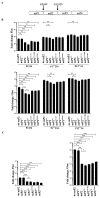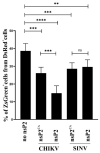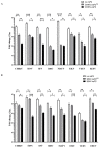Expression of Alphavirus Nonstructural Protein 2 (nsP2) in Mosquito Cells Inhibits Viral RNA Replication in Both a Protease Activity-Dependent and -Independent Manner
- PMID: 35746799
- PMCID: PMC9228716
- DOI: 10.3390/v14061327
Expression of Alphavirus Nonstructural Protein 2 (nsP2) in Mosquito Cells Inhibits Viral RNA Replication in Both a Protease Activity-Dependent and -Independent Manner
Abstract
Alphaviruses are positive-strand RNA viruses, mostly being mosquito-transmitted. Cells infected by an alphavirus become resistant to superinfection due to a block that occurs at the level of RNA replication. Alphavirus replication proteins, called nsP1-4, are produced from nonstructural polyprotein precursors, processed by the protease activity of nsP2. Trans-replicase systems and replicon vectors were used to study effects of nsP2 of chikungunya virus and Sindbis virus on alphavirus RNA replication in mosquito cells. Co-expressed wild-type nsP2 reduced RNA replicase activity of homologous virus; this effect was reduced but typically not abolished by mutation in the protease active site of nsP2. Mutations in the replicase polyprotein that blocked its cleavage by nsP2 reduced the negative effect of nsP2 co-expression, confirming that nsP2-mediated inhibition of RNA replicase activity is largely due to nsP2-mediated processing of the nonstructural polyprotein. Co-expression of nsP2 also suppressed the activity of replicases of heterologous alphaviruses. Thus, the presence of nsP2 inhibits formation and activity of alphavirus RNA replicase in protease activity-dependent and -independent manners. This knowledge improves our understanding about mechanisms of superinfection exclusion for alphaviruses and may aid the development of anti-alphavirus approaches.
Keywords: RNA replication; alphaviruses; mosquito; nsP2; protease; superinfection exclusion.
Conflict of interest statement
The authors declare no conflict of interest. The funders had no role in the design, execution, interpretation or writing of the study.
Figures




Similar articles
-
Semliki Forest Virus Chimeras with Functional Replicase Modules from Related Alphaviruses Survive by Adaptive Mutations in Functionally Important Hot Spots.J Virol. 2021 Sep 27;95(20):e0097321. doi: 10.1128/JVI.00973-21. Epub 2021 Jul 28. J Virol. 2021. PMID: 34319778 Free PMC article.
-
nsP4 Is a Major Determinant of Alphavirus Replicase Activity and Template Selectivity.J Virol. 2021 Sep 27;95(20):e0035521. doi: 10.1128/JVI.00355-21. Epub 2021 Jul 28. J Virol. 2021. PMID: 34319783 Free PMC article.
-
A Chikungunya Virus trans-Replicase System Reveals the Importance of Delayed Nonstructural Polyprotein Processing for Efficient Replication Complex Formation in Mosquito Cells.J Virol. 2018 Jun 29;92(14):e00152-18. doi: 10.1128/JVI.00152-18. Print 2018 Jul 15. J Virol. 2018. PMID: 29695432 Free PMC article.
-
Alphavirus nsP2: A Multifunctional Regulator of Viral Replication and Promising Target for Anti-Alphavirus Therapies.Rev Med Virol. 2025 Mar;35(2):e70030. doi: 10.1002/rmv.70030. Rev Med Virol. 2025. PMID: 40064592 Free PMC article. Review.
-
Alphavirus positive and negative strand RNA synthesis and the role of polyproteins in formation of viral replication complexes.Arch Virol Suppl. 1994;9:393-405. doi: 10.1007/978-3-7091-9326-6_39. Arch Virol Suppl. 1994. PMID: 8032270 Review.
Cited by
-
Activity, Template Preference, and Compatibility of Components of RNA Replicase of Eastern Equine Encephalitis Virus.J Virol. 2023 Jan 31;97(1):e0136822. doi: 10.1128/jvi.01368-22. Epub 2022 Dec 19. J Virol. 2023. PMID: 36533950 Free PMC article.
-
Japanese encephalitis virus inhibits superinfection of Zika virus in cells by the NS2B protein.J Virol. 2024 Mar 19;98(3):e0185923. doi: 10.1128/jvi.01859-23. Epub 2024 Feb 27. J Virol. 2024. PMID: 38411948 Free PMC article.
-
Trans-Amplifying RNA: A Journey from Alphavirus Research to Future Vaccines.Viruses. 2024 Mar 25;16(4):503. doi: 10.3390/v16040503. Viruses. 2024. PMID: 38675846 Free PMC article. Review.
-
Venezuelan equine encephalitis virus non-structural protein 3 dictates superinfection exclusion in mammalian cells.Npj Viruses. 2024 Sep 13;2(1):43. doi: 10.1038/s44298-024-00055-z. Npj Viruses. 2024. PMID: 40295792 Free PMC article.
-
Chikungunya virus release is reduced by TIM-1 receptors through binding of envelope phosphatidylserine.J Virol. 2024 Aug 20;98(8):e0077524. doi: 10.1128/jvi.00775-24. Epub 2024 Jul 15. J Virol. 2024. PMID: 39007616 Free PMC article.
References
-
- Nasar F., Palacios G., Gorchakov R.V., Guzman H., Da Rosa A.P., Savji N., Popov V.L., Sherman M.B., Lipkin W.I., Tesh R.B., et al. Eilat virus, a unique alphavirus with host range restricted to insects by RNA replication. Proc. Natl. Acad. Sci. USA. 2012;109:14622–14627. doi: 10.1073/pnas.1204787109. - DOI - PMC - PubMed
-
- Vega-Rúa A., Zouache K., Girod R., Failloux A.B., Lourenço-de-Oliveira R. High level of vector competence of Aedes aegypti and Aedes albopictus from ten American countries as a crucial factor in the spread of chikungunya virus. J. Virol. 2014;88:6294–6306. doi: 10.1128/JVI.00370-14. - DOI - PMC - PubMed
Publication types
MeSH terms
Substances
Grants and funding
LinkOut - more resources
Full Text Sources
Medical

